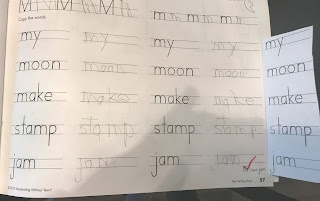
I am not a handwriting expert nor an occupational therapist; however, in my 11 years in the classroom and in teaching my own son, I have learned many things about teaching a child to write. A lot of people worry about which hand their child should use. And the answer is….whichever is most comfortable for him/her. To begin with, I work really hard when a child is little to place objects in the middle to allow the child to determine on their own which hand to use with a tool. This allows a child to develop their own sense of handedness.
As a teacher in PreK classrooms in multiple states and settings, I always worked to allow and encourage children to experiment with using both hands to do activities. Most children pick a dominant hand between the ages of 4-6. However, my own son, who is now 6 ½, still has not picked a dominant hand. While he is right eye and right foot dominant, he still has not picked a dominant hand. Knowing that we have a family history of left-handed and ambidextrous people on both sides of the family, I decided to work with him on developing his left-handed writing and cutting skills as he seemed SLIGHTLY more proficient with his left hand. However, when I did this, I did not consider the accommodations he would need to be left-handed in what is essentially a right-handed world. As a result, I have had to learn to make some accommodations and changes to curriculum as well as visuals we use.
Simple Changes that Make a Big Difference
When I made my son’s first school work checklist, I put the checkboxes on the right. That’s where I, as a right-handed person, would have wanted them so I can see what I am checking off.
Soon, I realized that for my left-handed son, this was not going to work. So I tried to modify it to see if it helped…
However, my son, who is ASD, took issue to the fact that I was modifying his schedule to create boxes on the “wrong side” as he saw it. So the following week, we started with a new checklist, including a new picture picked out by my son…
Left-Hand Accommodations Expanded
In talking with other parents about accommodations they have made for left-handed children, simple things such as binding a notebook on the right instead of left-hand side can make a big difference.
When we do handwriting, sometimes the way they set up the page doesn’t work for my son, so I copy the page, cut out the list of words and tape them along the side so he can copy from the right instead of the left.
I also learned to stop and think about the shape of writing tools. I bought some awesome rock crayons from a company started by an Occupational Therapist, only to discover that they lend themselves to right-handed individuals rather than left-handed. I was disappointed, but it made me realize that not everything is designed for left-handed use. I even bought left-handed scissors, which made a huge difference. Fiskars brand scissors can be used for either hand, but left-handed scissors are still more comfortable for left-handed use. Also, when we sit down to work together, I always sit on my son’s right side so his left hand is free to write and move without bumping into me.
More Information to Explore
Want more information on how to determine handedness and how to accommodate left-handed students? Check out these links:
Left-Hand Teaching Help:
5 ways to support a Left Handed Student
10 Objects Left Handed People Struggle With
Teaching Left-Handed Children
Tips for Teaching Left-Handed Children to Write
Determining Handedness in Kids:
How to Determine If Your Child is Left or Right Handed
Spotting a Left-Handed Child
Activities that Can Help Develop Handedness
And remember, the most important thing is how comfortable your child is with his/her tools. Play-doh, paper tearing, playing with stickers, pouring sand or water in and out of containers, and just scribbling are all important parts of building muscles for writing too. So have fun, and enjoy exploring handedness with your children!
Did you benefit from this article?
Would you consider a small donation to support the ongoing work of SPED Homeschool?
Click Here to Donate Today






